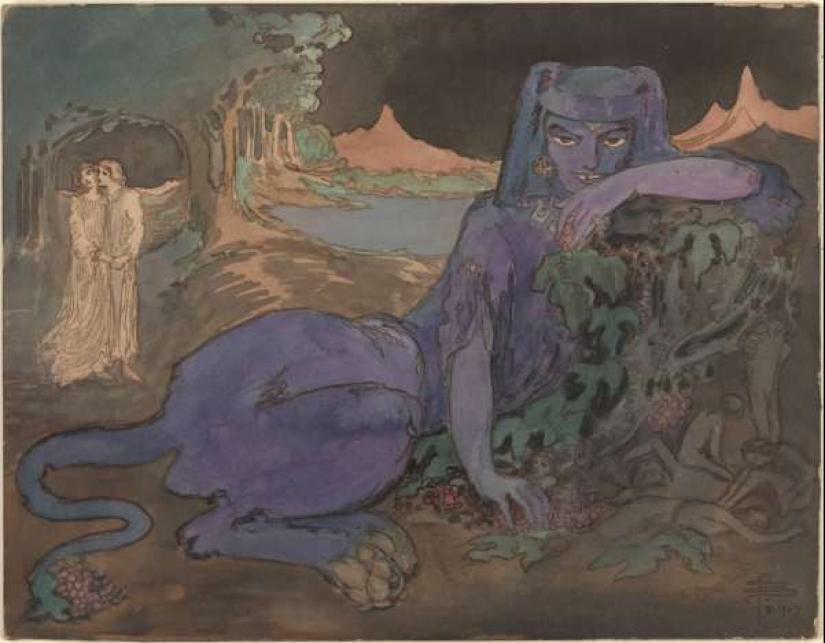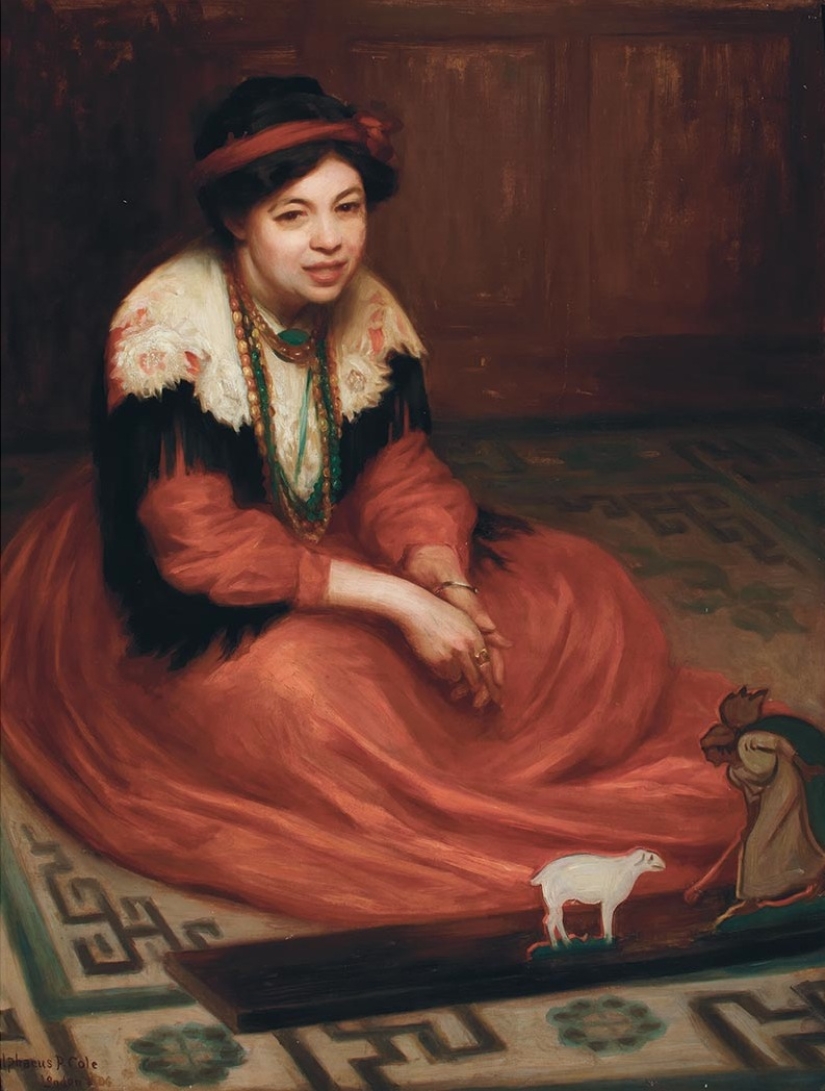How the Classic Rider-Waite Tarot Deck was Born — The Story of Pamela "Pixie" Coleman-Smith
Categories: Celebrities | Design and Architecture | World
By Pictolic https://pictolic.com/article/how-the-classic-rider-waite-tarot-deck-was-born-the-story-of-pamela-pixie-coleman-smith.htmlAnyone who is seriously interested in esotericism is probably familiar with the Rider-Waite Tarot deck. To date, it is the most popular deck for divination on the planet. Despite this, few people know the history of its appearance and the people thanks to whom these classic cards were born.

The design of the Rider-Waite Tarot deck was developed in 1910 by Arthur Edward Waite, an honorary member of the mystical order "Golden Dawn" and a famous researcher of Freemasonry and Kabbalah. The first publisher of these cards was William Ryder from London, whose name was also included in the name of the deck.
Many people believe that these people have also prepared magnificent drawings of maps, thanks to which they became famous, but this is not the case. The artist of the deck was Pamela Coleman-Smith — a mysterious and talented woman whose life is covered with speculation and rumors.

Contemporaries describe Pamela as a woman with an exotic appearance for Europe. She actually stood out from the crowd with an Asian cut of her eyes, plump lips like the inhabitants of Africa and dark skin. Colman-Smith also dressed unusually — her Rastafarian picturesque outfits invariably attracted attention.
Many of Pamela's acquaintances were sure that there was a share of African blood in her veins — the woman knew the folklore of the Black continent and Jamaica perfectly well and told Afro-Jamaican fairy tales. One of her contemporaries described her as a "strange African deity."
Oddly enough, such an exotic girl came from an ordinary family with native English roots. Pamela's mother, Corinna Coleman, was an actress, and her father, Charles Smith, was a railway engineer. Charles was 12 years younger than his wife, which was very rare at that time.

When Pamela turned 10, her father was offered a job in Jamaica, where the railway system was expanding. The family moved to an exotic island and the girl immediately fell in love with this place with all her heart. During the 4 years spent there, Colman-Smith became a true connoisseur of local fairy tales and legends. Pamela was attracted by the special mysticism inherent in Jamaica and its inhabitants, which left an imprint on her entire life and work.
A little later, Pamela realizes her love for the island by writing and illustrating several books with Jamaican fairy tales, the most famous of which will be the collection "Annansi Stories", dedicated to the traditional hero of Afro-Jamaican folklore spider Annansi.

A big role in the life of Colman-Smith was played by her aunt Helen Terry, to whom the girl was given for upbringing in 1889. She was a talented actress and the best female performer in Shakespearean productions in Britain. Terri gave Pamela the nickname "Pixie", which perfectly suited the petite and nimble girl. In traditional English mythology, Pixie is a kind of elf. This name remained with her for the rest of her life.
Pamela found a friend in Helen's family — her cousin Edie. They not only played together, but also drew a lot, portraying themselves as fabulous flying creatures. Later, Pamela decided that drawing is not just a hobby and decided to devote her life to this kind of creativity.

At the age of 15, Coleman-Smith entered Pratt Institute in New York to study painting. Her mentor was Arthur Doe, a well—known artist and connoisseur of Japanese medieval art. Doe had a special approach to drawing — he believed that it was akin to writing music, but instead of notes, colors, shadows, shape and volume were used. Doe had a profound influence on the formation of Pixie Coleman-Smith as an artist — Japanese motifs were often traced in her works.
Pamela could not finish the institute — the girl was prevented by the sudden death of her mother and her own prolonged illness. When Pixie turns 21, her father dies and the girl is left completely alone. Coleman-Smith starts working as an illustrator, despite the lack of a diploma and her work is in demand.

After a while, the girl returns to Aunt Helen in London and gets a job as a theater designer. In 1901, Pixie opened her own studio, where artists, writers, poets and other creative people gather every week. Arthur Rance, one of the regulars of such evenings, describes Pixies as
It was said that the room in which Pixie lived was very unusual. The room looked more like an antiquities shop and was incredibly colorful. The hostess of the room herself, dressed in bright African clothes, organically fit into the interior and looked like the heroine of one of her amazing fairy tales.

Fame came to the artist in 1907, when she met Alfred Stieglitz, an expert and propagandist of photography and painting. He selected the best works of the artist for his gallery and they immediately interested not only specialists, but also ordinary visitors. Pamela's 33 works were soon bought by connoisseurs of her unusual creativity.
Pixie was distinguished by incredible productivity and passion for creativity. In one of the letters to friends, Pamela said that she had created 94 drawings in a week! The speed of work, combined with undoubted talent, became one of the main reasons why Waite chose Coleman-Smith to create his famous Tarot deck.
Pixie met Waite in 1901, when she joined the mystical order of the Golden Dawn, whose motto was: "Quod Tibi id Aliis" — "What is for you, is for others." Soon there was a split in the order and Waite organized his own branch of the society, which Pamela Coleman-Smith joined.

Work on the deck began in 1909 and lasted for a whole year. Pamela had to create a huge number of sketches and sketches. That's where her incredible performance came in handy. In this work, compliance with the canons that were developed centuries ago played an important role.
Pixie managed to keep the traditional style of the deck, while realizing her vision of cards. The minor arcana of the Rider-Waite Tarot is completely invented by the artist. Pamela's work was inspired by ancient cards, such as the Solo-Bosca Tarot, created back in the XV century. The work took place at a furious pace, but this did not affect the quality of the master's drawings — they were flawless.

In a letter to Alfred Stieglitz in New York, Pixie wrote that it was a monumental and very urgent job for negligible money. Therefore, it can be assumed without reason that Colman-Smith, who was already a fairly well-known and sought-after artist at that time, worked on pure enthusiasm.

Pixie didn't see any money, or even appreciation from Waite. Her name was never mentioned among the authors of the deck and in the book attached to the cards, she was mentioned only as a "young female artist". It is quite possible that in the process of work between the customer and Pamela had some kind of conflict, because of which Waite disliked Pixie.
The deck exceeded all expectations. It immediately became a bestseller and broke sales records for a century. Her appearance caused a whole wave of imitations, but none of them could repeat the success of the original. Unfortunately, neither the original drawings nor a huge number of sketches have been preserved.
It is believed that 80 final versions of drawings for maps remained in the archives of the publishing house "William Ryder and Sons", but unfortunately they died during the Second World War during the bombing of London by German aircraft.

Surprisingly, the Tarot deck put an end to Pixie's career. After the success of her work, a period of oblivion and despair came. Pamela's paintings and drawings were not sold, and publications were not interested in her illustrations. It seemed that fate wanted the deck of cards to remain the most famous, unsurpassed brainchild of Colman-Smith.
Desperate to realize herself in the professional sphere, Pixie plunged headlong into public life. In 1910, she joined the suffragette movement and actively joined the struggle for women's suffrage. Along the way, Pamela draws themed posters for events and posters for the Red Cross. During the First World War, Pixie organizes the collection of toys for children affected by the fighting and participates in numerous charity fairs and evenings.
In 1918, Pixie left the mystical order, converted to Catholicism and moved from noisy London to the provincial resort park Garland. There the artist bought a small house with a chapel, in which she organized a rest house for priests. In addition to the clergy, people of art also visited her house. Pamela planned to create a colony of artists in her Lizard boarding house, but her initiative did not find a response from anyone.

Soon Coleman-Smith receives an inheritance from his uncle and closes his business, which does not bring any income. Very little is known about the last 35 years of Pixie's life. Pamela has never been married and had no children. She did not become rich and famous, but quietly lived out her life with a companion, Nora Lake. Pamela Coleman-Smith died in 1951 in Cornwall and was buried in a common grave with the poor.
There was no procession or mourners during the funeral — only her faithful friend Nora Lake accompanied Pixie to eternity. The artist bequeathed her property to her companion, but there was nothing of value in her room except books and drawings. To pay off her friend's debts, Lake was forced to sell all her possessions at auction.
Did you know that there is a Tarot deck based on the series "Game of Thrones"?
Recent articles

It is well known that a person sleeps a third of his life. It is not surprising that so many customs are associated with sleep. ...

Even in the middle of the XX century, when people came close to solving the mystery of the atom and was looking for ways to reach ...

A year before Madonna first appeared on television and confidently told American Bandstand host Dick Clark that she was going to ...